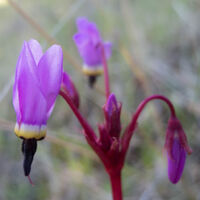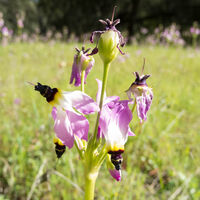shooting stars
(primroses)
genus Primula
Member of
primrose family (family Primulaceae)
dicots (class Magnoliopsida)
flowering plants (subphylum Angiospermae)
There are no other wild species of this genus in the bay area.
The anthers of Shooting stars are fused in pairs, with connective tissue between and covering them, often coming to a point between the tips of each anther pair. The connective tissue widens to cover the anthers toward the proximal end, where all filaments are often fused to form a filament tube.
Jepson has produced a video showing differences between the bay area species, along with high quality photos. Another video describes the relevant botanical terms in more detail.
Primula clevelandii
- peduncle bright green
- corolla typically has 5 lobes, rarely 4 or 6
- at low elevations near the coast, the corolla is typically mostly white
- inland and at higher elevations, the corolla is mostly light purple
- filament tube 3–4 mm wide
- depending on the variety, there will always be cream/yellow on the filament tube, anther connective tissue, or anther pollen sacs
- [basal, not spoon-shaped] leaf blade length generally > 2× width
Toxicity of primula (Primula spp.):
1 – Skin contact with these plants can cause symptoms ranging from redness, itching, and rash to painful blisters like skin burns.
2 observed taxons / 1 key
Locations: Months: For more details, use advanced search.
Chris’s observations: 86 (79 are research grade)
Taxon info: iNaturalist – Calflora – Jepson eFlora – FNA
Bay Area species: iNaturalist – Calflora

